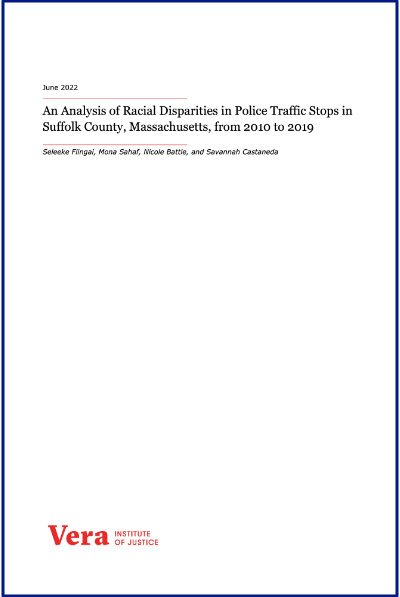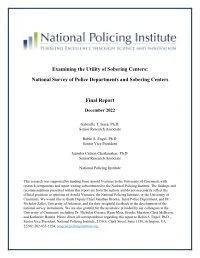By The Virginia Department of Criminal Justice Services
The Community Policing Act of 2020 (HB 1250; “the Act") mandated that the Virginia State Police (VSP) and other state and local law enforcement agencies, including police departments (PDs) and sheriff’s offices (SOs), begin collecting and reporting data on traffic stops as of July 1, 2020. State law enforcement agencies, PDs, and SOs are required to collect data on the race, ethnicity, and other characteristics of the drivers stopped, and on other circumstances of the stop such as the reason for the stop, whether any individuals or vehicles were searched, and the outcome of the stop (arrest, citation, warning, etc.). All reporting agencies are to submit this data to VSP, who maintain the data in the Community Policing Database.
The Act also mandated that the Virginia Department of Criminal Justice Services (DCJS) periodically obtain data from the Community Policing Database and produce an annual report “for the purposes of analyzing the data to determine the existence and prevalence of the practice of bias-based profiling and the prevalence of complaints alleging the use of excessive force." Such reports shall be produced and published by July 1 of each year.
This is the third of these reports from DCJS. It contains a review of how the data was collected and analyzed as well as preliminary findings of data from 650,387 traffic stops reported in Virginia during the nine-month period between July 1, 2022, and March 31, 2023. This report also presents the findings from analyses of statewide data; aggregated data from the seven VSP Divisions; and data from each individual law enforcement agency that reported sufficient data to the Community Policing Database.
The information presented in this report is preliminary and should be interpreted with caution. Although this analysis identified disparities in traffic stop rates related to race/ethnicity, it does not allow us to determine or measure specific reasons for these disparities. Most importantly for this study, this analysis does not allow us to determine the extent to which these disparities may or may not be due to bias-based profiling or to other factors that can vary depending on race or ethnicity. These other factors include differences in locations where police focus their patrol activities, differences in underlying regional populations, differences in driving patterns among individuals, and the lack of a scientifically established baseline for determining the number of drivers in each racial/ethnic group who are on the road and subject to being stopped while driving.
The analysis of racial disparity is a complex field with a vast array of potential contributing factors. Many data elements could play influential roles in racial/ethnic patterns of traffic enforcement but are unavailable to DCJS. Factors like the race of the officer performing the stop, agency policies and community priorities driving enforcement patterns, police report narratives outlining legal justifications for stop, search, and arrest can all inform stop patterns but are not within the current purview of available Community Policing Act data. Additionally, the data presented in this report cannot reflect any stop trends from agencies which did not provide data or records that were excluded for completeness issues. As such, while the report presents stop, search, and arrest disparities based on the available data, they should not be construed as complete and final proof of disparity OR any explanation of contributing factors which drive genuine disparities which may exist.
This report does not tabulate the many positive actions that can occur for a traffic stop such as seizures of guns, confiscation of drugs, and ensuring valid and current drivers’ licenses. The Community Policing Act imposes narrow requirements for data collection and analysis, and any benefits of traffic or pedestrian stops are not within the scope of the law.
While DCJS and VSP have introduced process improvements based on lessons learned in past reporting, the Community Policing Act is still in the early stages of implementation. More and better data, as noted in the recommendations, is needed to make the observations in this report more than directional, and the costs of such data gathering need further evaluation. As the report notes, many PDs and SOs − especially smaller agencies with limited resources − continue to face challenges establishing the data collection and reporting required under the Act. The majority of local law enforcement agencies (LEAs) in Virginia (255, or 74%) employ 50 or fewer sworn officers, including 118 (or 34%) employing 10 or fewer sworn officers. Many of these agencies have faced challenges fulfilling all requirements imposed by the Act and aligning their collection practices with the changes introduced since first implementation of the Act. For this reason, some agencies were unable to report complete data responsive to the Community Policing Act for the entire year, and in some cases the quality of the data was limited. Additionally, a substantial number of smaller agencies reported so few traffic stops that it was not possible to interpret data related to driver race/ethnicity. The state may wish to consider providing additional resources to LEAs, particularly smaller agencies, to support their ability to comply with the data-related provisions of the Act.
Another important limitation to the data and findings presented in this report relates to the race/ethnicity data in the Community Policing Database itself. Because the state lacks a standardized mechanism for reporting the race or ethnicity of a given driver, law enforcement officers must either make their own determination about a driver’s race/ethnicity (which may or may not be accurate) or ask for that information in the course of the traffic stop, which could raise constitutional concerns or escalate the perception of conflict in certain situations. Virginia does not collect and store information about a driver’s race/ethnicity, whether in driver-related databases maintained by the Virginia Department of Motor Vehicles or on individual driver’s licenses. Whether and to what extent the data related to driver race/ethnicity in the Community Policing Database accurately captures this information cannot be determined without further review.
The factors described above limited the ability of DCJS staff to conduct any complex statistical analysis of the data or to draw any firm conclusions about the existence and prevalence of the practice of bias-based profiling in a given agency or jurisdiction. It is anticipated that the reporting, analysis, and interpretation of Community Policing Act data will improve in the future as the program matures.
Richmond: Virginia Department of Criminal Justice Services, 2021. 73p.





















